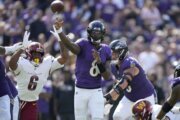[IMAGE]
Without any coherent federal guidance, states are left to try to figure out how to best prevent the spread of the novel coronavirus, the cause of COVID-19, while also opening as much of the economy as possible. Some states, like New York, took drastic measures to close down, with great success. New York has reduced its infection and hospitalization rates to those at the very beginning of the outbreak in February. Others, like Florida, Texas and California, have learned the hard way that opening too soon can allow the virus to come roaring back and cause spikes in infections, hospitalizations and deaths — and are now closing some businesses again.
Just how safe are the various activities that we all long to return to? These three infectious disease experts give their opinions on everything from bars and bowling to hair salons and houses of worship:
— Colleen McLaughlin, Ph.D., chair of the Population Health Sciences Department at the Albany College of Pharmacy and Health Sciences in Albany, New York.
— Dr. Karen Ravin, chief of infectious diseases at Nemours/Alfred I. duPont Hospital for Children in Wilmington, Delaware.
— Dr. John Swartzberg, clinical professor emeritus of infectious diseases and vaccinology at the University of California–Berkeley-University of California–San Francisco Joint Medical Program and the UC Berkeley School of Public Health.
These ratings are an average of their opinions, and are based on certain assumptions:
— Everyone wears a face mask.
— Social distancing practices are in place as much as possible.
— Local infection rates are low to moderate.
— Coronavirus testing is being done.
[See: What Are the Symptoms of Coronavirus?]
“It depends on what’s happening at the local level, in the community, in their state,” Ravin says. “Is testing being done? How many people are testing positive? Current thinking is that it’s safest if the rate of positive is less than 5% and the lower the better.”
In general, Ravin adds, outdoor activities are safer than indoor ones. Shorter activities are safer than longer ones. Activities with fewer people are safer than events with large crowds. “Another important concept is to have an exposure budget. Don’t immediately return to all your usual activities and don’t do them all in one day or week, space them out as much as much as possible,” she says.
Swartzberg warns that all of these activities could have a higher or lower risk ranking, “depending upon how one conducts themselves: wearing a mask, social distancing, hand hygiene.”
In other words, it’s mostly up to you to control your risk — and to protect others. Given these caveats, here are the safety ratings from these three experts, from most risky to least risky.
Sports Stadiums With Crowds: 10
“As this virus’ favorite way of transmitting is by having people close together yelling (and, therefore, expelling a lot of viruses), attending a sporting event, especially indoors, is incredibly hazardous,” Swartzberg says.
Bars: 9
“No masks, alcohol, lots of strangers, crowds, karaoke — all signs of danger,” McLaughlin says. “Any event where you and others are drinking is risky because of lowered inhibitions. Start drinking and you are unlikely to put your mask back on that night. Get together with your friends around a campfire. You won’t pick up a date, but at least you can get out.”
Buffets: 9
“All the risk from indoor restaurants, plus people moving around and serving themselves,” McLaughlin says. “It’s unlikely you will get the coronavirus from the food, but you will be touching utensils used by a lot of other people. Why risk it?”
Airplanes and Airports: 8
“I absolutely would not fly unless the airline required masks at all times and spread people out — more spread than I’ve seen advertised, like one person every other row,” McLaughlin says. “As with some of the other activities on this list, you will be stuck there a while and people will take off their masks to eat and drink. And on a plane, what can you do if the person behind you starts to cough? Some people have no choice but to fly for their jobs. Let’s leave the planes safe for them.”
Amusement Parks: 8
Screams and laughter mean air droplets, and that means potential spreading of the virus. Even though most park activities are outside, getting children and teens to wear masks will be difficult and hard to enforce.
Gyms: 8
Working out in a mask is uncomfortable, but breathing hard is the virus’ dream environment. Get your exercise at home, the experts recommend.
Crowded Houses of Worship With People Singing: 8
These places could be lower risk if people are wearing masks, maintaining social distancing and not doing a lot of singing or talking, Ravin says. “If they were taking these precautions, I’d drop the risk level to a 6,” she explains.
Playing Basketball: 8
On the court, 6-foot social distancing is impossible. Playing one-on-one against someone you know is taking COVID-19 seriously lowers the risk, but stay away from pickup games with strangers.
Public Pools: 8
“Crowded pools with Marco Polo games are a no-go,” McLaughlin says. “Splash pads with families keeping to their own space are a good option to help the kids cool off.”
Casinos: 7
Indoors, crowds, alcohol, no social distancing, lots of people touching the same machines: stay away.
Hair Salons and Barber Shops: 7
Here, the risk can be lower if the salon is taking precautions seriously, including cleaning more, spacing out appointments and wearing masks or face shields and protective gowns. Call and ask what your salon is doing to protect customers.
Movie Theaters: 7
Again, this could be lower with serious distancing and patrons who wear masks, but any place with a crowd presents some risk. “Personally, I wouldn’t risk it yet. You will be there for over an hour, and you cannot control what others do,” McLaughlin says.
Dinner Parties: 5
“This could be 1 or 10, so call it 5,” Swartzberg says. “The score would depend upon how many people, how careful they had been, if there’s social distancing, and if everyone brings their own utensils, plates and glasses. So, another couple who had been sheltering in place coming over for dinner would be a 1 or 2. A large party, on the other hand … ”
Indoor Seating at a Restaurant: 5
“If restaurants are taking proper precautions, spacing out tables, having specific reservation and seating times, enforcing mask wearing for all patrons when not at their tables and servers all the time, making sure staff does appropriate hand hygiene and the restaurant is not too crowded, then I think the risk is maybe a 5,” Ravin says. However, McLaughlin notes that a recent study out of China showed that the coronavirus was spread by an air conditioning unit at a restaurant. “The unit blew air into the room, so people sitting near a table with a person who had the coronavirus were exposed,” she says. Many of the recent spikes in infection around the country have been traced to restaurants and bars, so this rating may need to be increased as more data are collected.
[See: Myths About Coronavirus.]
Crowded Malls With Social Distancing and a Mask: 4
“Malls are probably a bit lower risk because the time of contact with any one person is very brief and the area is large, but crowds and people not masking would both increase the risk,” Ravin says. McLaughlin adds that stores may set up ways for shoppers to keep their distance while flowing in and out, “but you will still be reliant on others to help keep you safe. Please, everyone, wear your mask over your nose!”
Bowling With Mask and Social Distancing: 3
Fairly low risk if you are bowling within your “social bubble” of family and friends you know are taking COVID-19 seriously, bowlers are spaced out to every other lane and there is no eating or drinking. If you see others downing beers, sharing French fries and whooping it up, ask for a lane far away from them.
Hotels: 3
Large hotel chains are generally taking the pandemic seriously and have put strict cleaning and social distancing policies in place. Still, it’s best to say out of a hotel unless you have to travel for business or for some other unavoidable reason.
Libraries and Museums: 3
Assuming patrons all wear masks, maintain social distancing and limit their time inside, the risk is fairly low.
Outdoor Barbecue: 3
Backyard barbecues with fewer people are less risky than indoor parties, and the risk is even lower if everyone brings their own cutlery and plates, wears masks when they are within 6 feet of anyone who is not a member of their immediate household and are seated far enough apart.
Outdoor Restaurants 6 Feet From Others: 3
As long as tables are far apart and staff take appropriate precautions, the risk is fairly low, our experts agree.
Work Offices: 3
As with other indoor spaces, it all depends on everyone wearing masks, staying 6 feet apart, washing hands often and being careful in break rooms, meeting rooms and other gathering areas.
Beaches With Social Distancing: 2
Pick a beach that isn’t too crowded and where they enforce social distancing rules. Also avoid snack bars, picnic areas and any other communal gathering places. Bring your own food and drinks.
Camping: 2
Avoid others and camp only with family or others in your social bubble.
Getting Groceries: 2
Generally safe — with masks, social distancing and hand-washing, of course.
Getting Takeout: 2
There is no evidence that the virus lives in food. However, just to be safe when you order takeout, remove the food from their containers and put it on your own plates, and then throw out the packaging and wash your hands thoroughly before eating. There is a small risk that the virus can live on packaging and other hard surfaces.
Golf: 2
Generally safe in groups of four or fewer. Stay 6 feet apart, don’t share carts or golf clubs, don’t touch rakes or pins or ball washers — and no 19th hole, of course.
Medical/Dentist Offices: 2
“Dentist and doctor’s offices are taking so many precautions right now that the risk is almost negligible,” Ravin says. “There is an emphasis on staff screening, mask wearing by all, great attention to hand hygiene and environmental cleaning. I would put both at a 2 or 3 at the most.”
[See: Foods That Can Support Your Immunity.]
Tennis: 2
Keep an empty court between you and another game, and avoid clubhouses, locker rooms and other gathering spots.
Walk, Run or Ride With Others: 2
Make sure you maintain the same rules as other small-group outdoor activities.
Getting Fuel: 1
Wipe the fuel pump handle with an antiseptic wipe or use a glove to ensure the virus isn’t transferred by the handle — though that is highly unlikely anyway.
More from U.S. News
Meet the Woman Behind the World’s Most Famous Coronavirus Tracker
What You Need to Know About Coronavirus Testing
Foods That Can Harm Your Immunity
COVID-19: How Safe Are You When Activities Reopen? originally appeared on usnews.com







